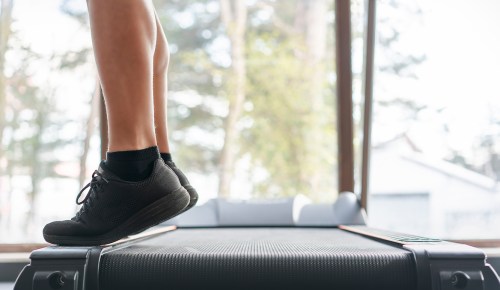6 Reasons Why Fitness Pros Recommend This Simple Calf Exercise to Pretty Much Everyone
Calf raises increase strength, helping with all lower body movements, injury prevention and running speed.

Have you ever felt off-balance while walking? Or experienced shin splints or knee pain during your workouts? Or felt like no matter how much you were running, you couldn’t get faster? For all these scenarios, there’s a simple solution: Calf raises.
Experts in This Article
digital fitness development manager at Orangetheory
certified personal trainer
“Calf raises are a simple but super effective and beneficial exercise to add to your workout routine,” says certified personal trainer and WW Digital 360 coach Lindsey Lauten.
And yet, too many of us ignore our lower legs. “Calves are one of the most under-trained muscles in your body and often forgotten about in a strength program,” Lauten says. “Don’t underestimate what training your calves can do for you.”
Why are calf raises so beneficial?
In short, they contribute to just about all lower body movement. “Strong and powerful calves can help improve your run, jog, or walk, adding strength and stability to your gait,” explains Erin De Groot, an Orangetheory coach who helps design the studio’s workouts. “Those jump squats you love so much in your Orangetheory class? Yup, they help with those, too. Any activity that involves being on your feet and moving in any way will benefit from adding calf raises into your resistance training routine.”
“Any activity that involves being on your feet and moving in any way will benefit from adding calf raises.” —Erin De Groot
But that’s not all. Lauten says that calf raises can also help increase your speed as a runner: Since the calf muscles are responsible for that final push-off from the ground, building greater strength can send you farther on each stride. “Additionally, if you’ve ever felt knee pain after doing a few burpees or running on a treadmill, weak calves could be behind it,” she says. “Strengthening your calves can help this, and reduce your chances of an ankle injury.”
The same is true for shin splints. When you perform a calf raise, De Groot says that you’re targeting the two main muscles of the calf: the gastrocnemius and the soleus. Research shows that when these muscles are strengthened, they help stabilize the tibia, which effectively leads to less tension and pain associated with hitting the pavement or treadmill. “The calf raise targets both muscles without a ton of fancy equipment,” De Groot says, pointing out that bodyweight alone can help you make strength gains.
Even if you’re more focused on simply staying upright on the sidewalk than hitting a new PR, calf raises (and other calf stretches) can help. “One of the main benefits is that they help ensure you have proper balance by stabilizing your calves and feet,” says Lauten. “Your entire lower body depends on the strength of your calf muscles, so strengthening them is key.”
Stabilize and strengthen your lower body with this standing Pilates workout:
How to perform a calf raise
Although calf raises can be done with or without equipment, you’ll want to perfect the bodyweight form first before adding weights into the mix. “The simplest way is to stand tall with your feet flat on the ground, then push through the balls of your feet to elevate your heels,” De Groot says. “As you lower your heels back to the ground, move slowly and with control.”
Aim for higher reps—say, 12 to 20—for two to three sets at first to really master the movement. Once you’ve nailed it, De Groot says that there are a bunch of ways you can tailor your calf raise routine to your goals.
“If you’re looking to build more strength, adding more weight by using a calf raise machine (which will add resistance to the top of your shoulders) or dumbbells with a lower rep count is best,” she says, recommending six to 12 reps, for two to three sets. You can also increase the challenge with single-leg calf raises (though you may want to hold onto a wall or countertop to maintain your balance).
Alternatively, if your goal is to become a faster runner or more powerful jumper, De Groot recommends opting for explosive calf raises. “Use a tempo that explosively lifts your heels (concentric phase), then lowers them slowly back to the ground (eccentric phase),” she says.
Another way to switch things up is by swapping out the surface. “Calf raises can be performed on a raised surface, which will increase the range of motion in the movement,” De Groot says. Try this by letting your heels hang off the edge of a step.
You can also specifically target the soleus muscle by performing the movement with a bent knee, rather than a straight leg (which will primarily target the gastrocnemius). “If you really want to maximize your training sessions, add both varieties,” says De Groot.
How often should you perform calf raises?
According to the American College of Sports Medicine, all adults should perform strength training at least two days per week in an effort to target all major muscles, including your calves. But De Groot notes that you can perform calf raises outside of your two set days, too. “They are simple enough to be performed just about anywhere,” she says, “so the next time you’re making dinner or waiting in line at the coffee shop, get to work!”
Calf raises got your legs feeling overly tight? Roll them out with this five-minute routine:
Oh hi! You look like someone who loves free workouts, discounts for cutting-edge wellness brands, and exclusive Well+Good content. Sign up for Well+, our online community of wellness insiders, and unlock your rewards instantly.
Sign Up for Our Daily Newsletter
Get all the latest in wellness, trends, food, fitness, beauty, and more delivered right to your inbox.
Got it, you've been added to our email list.










